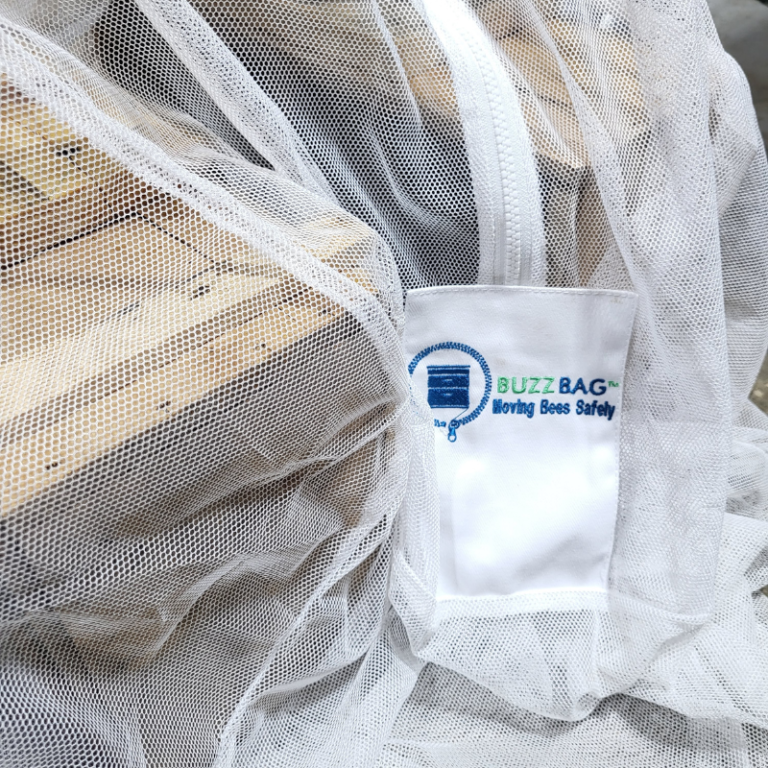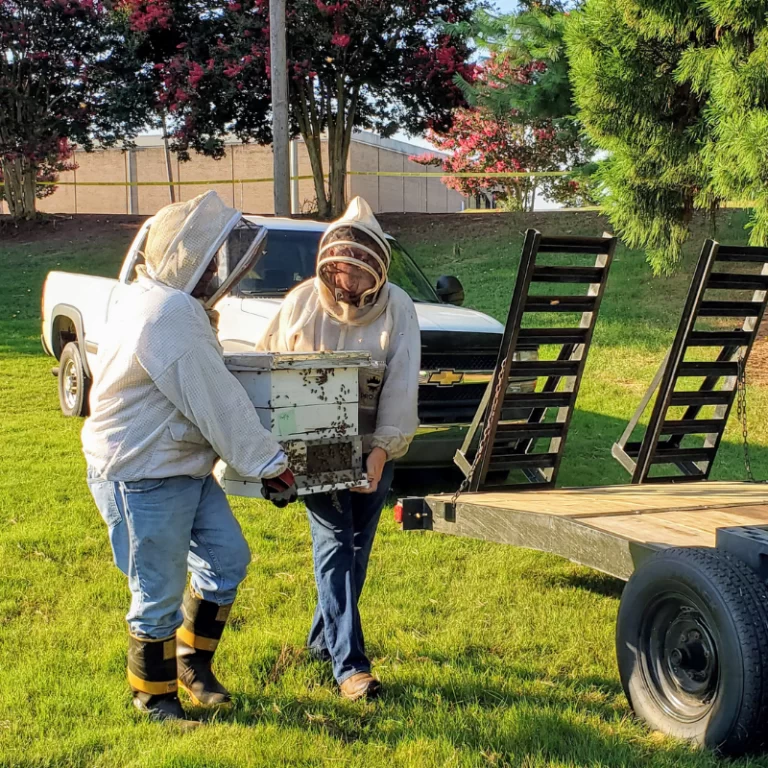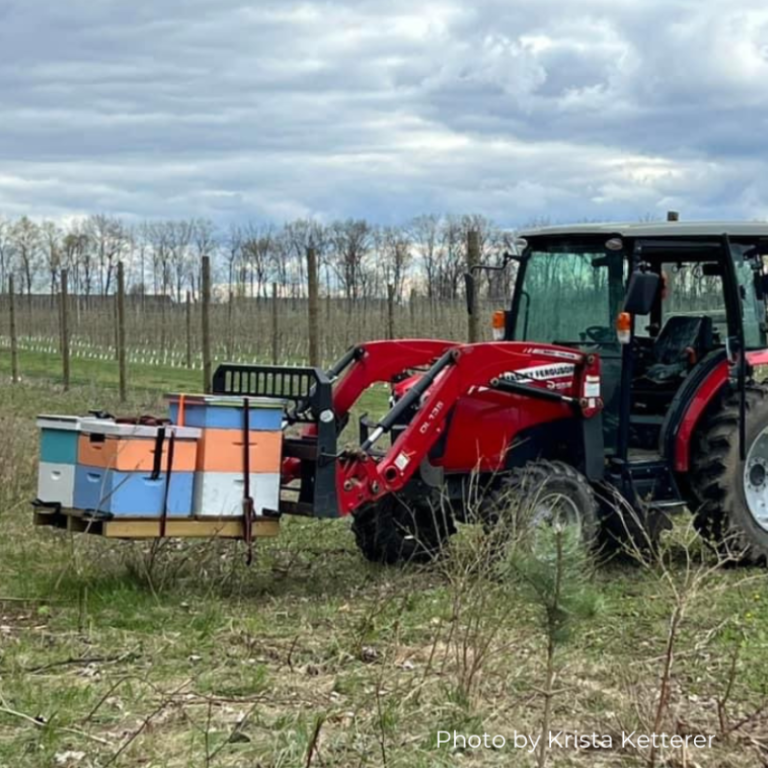Table of Contents
So, you put lots of thought into where you’d place your beehives, but for some reason or another, now you’ve got to move your honey bee hives. How do you safely move a heavy box or stack of boxes with 60,000 bees in it? First, here are a few things you’ll need:
a flatbed wheelbarrow, moving dolly, a strong back, a friend, a hand truck or a tractor with a pallet mover fork
Headlamps with red lights or red filters (for moving at night)
Ratchet straps: at least one per hive
A Foxhound Buzz Bag for extra security
Additionally, if you can enlist some help, preferably from another experienced beekeeper, that will be very helpful. Beehives can be very heavy, so having some other beekeepers to help with lifting, as well as having another set of eyes to check the seals and straps could save you a lot of trouble when you are moving beehives to a new neighborhood.
Most beekeepers will need to move a hive short or long distances at some point in their beekeeping career. If you need to transport bees, reach out to your beekeeping community for help and advice, especially if you are a new beekeeper.
Preparing To Move The Hive
Before moving bees, you’ll need to seal the entrances of the hives, but you also have to think about ventilation. If you seal the bees without adequate ventilation, they may die if they are trapped in hot weather or for several days.
Bees will cook in a sealed hive, even when it isn’t hot. You also need to consider the time of day and the temperature before you start this process.
If you can, you might want to catch and cage your queen to ensure that she won’t get squished or injured in the move.
If the hive body tilts or frames move at all, things could turn out badly for your bee colony. This isn’t a necessary step, but it could provide a little extra security.

Preparing The New Bee Yard

Prepare the new location before you move the hives. Set up your hive stands and choose a leafy branch or branches to place in front of each of the hive entrances to make the bees reorient.
This is helpful step if moving the bees within a couple miles of the original location. But if moving them further than that, the surroundings will be so different, you don’t need to do that.
Be certain that you’ll be able to park as close as possible and reach the location with whatever device you are using to move the hive.
Ventilation
To make sure that your bees have sufficient ventilation, you might give them a screened bottom board, and if possible, even a screened inner cover.
This isn’t as important in the winter when it is cold, but you can easily overheat a colony in the summer if it is sealed up for long.
You can make one with some wood and hardware cloth) For closing the hive entrance, a great option is Foxhound Bee Company’s universal reducer, turned so that both of the ventilated sides block the opening.
These should be screwed in at the hive entrance. Another entrance ventilation option is to use hardware cloth or a mesh screen and push pins.
Sealing The Hive
You’ll need to seal the entrance, the top, and if you are moving multiple boxes, you’ll need to seal the two brood boxes together. (If the hives you are moving have honey supers, remove those before moving, using a fume board and Bee Quick.
You can store them briefly and replace them after you transport the bees.) You can move them with all the boxes on the hive, but it will be much heavier.
See our blog, How does a fume board work?
You can tape the joints between boxes with duct tape, ratchet straps the bottom board, boxes and top together in one or both directions. Taping is important if you absolutely want to keep any bees from leaking out during transport.
Some hives have hive staples that connect the bottom board to the bottom box. These can be helpful when moving hives. You can add bag around the entire hive if you would like. They will fit a hive all the way from a package or nuc up to a full size double deep.
That way, if bees do escape, they’ll still be inside the bag, and you’ll avoid losing bees. It also makes it safer for those around you if they do get out.

Presumably, most of the bees are at home in the hive after dark, but even if you close the bee hive at night, you may not get all the bees. Wear your beekeeping suit or jacket, use your smoker, and with a few puffs, you can encourage honey bees who are hanging around outside the entrance to get onboard and move into the hive.

What Do Bees Do In The Winter?
So what happens to honey bees in the winter? Bees pretty much disappear from the flowers and our minds as well, not to be thought
Note that it is much easier to move bees during the winter. This is because the hives are smaller, the bees are more likely to stay in the hive and most of the bees will be in the hive.
If moving during the summer, even at night the outside of the hive will have hundreds or thousands of bees on it.
See our blog, What do bees do in the winter?
When To Move A Hive
The best time of day to move your bees is when it is dark—either early morning or late at night. Moving them when the sun is shining can cause them to overheat.
Closing up the hive in the dark ensures that you are capturing as many bees as possible since foragers go out when the sun is shining and come home at night.
At night, you can wear a red headlamp to see without becoming a target for lost or angry bees. Trust us, using the phone on your flashlight is the fast track to getting the bees to fly at your phone.
If you move the bees during the day, be careful not to leave the hive in direct sunlight too long when they are sealed up. If it is hot and you have a screened inner cover, take off the telescoping cover to give the bees more air circulation.
See our blog, Where do I put my bees?
Moving The Hives

When your beehives are sealed, move them from the old location as soon as you can. The less time they spend trapped inside the hive, the less angry they’ll be.
Park your vehicle as close as you can to the original hive location, whether it’s a tractor with pallet mover forks, a low trailer (this is a great option because you won’t have to lift the boxes so high), or a pickup truck.
Any of these options will be better than moving hives in your car or SUV, but if that is your only option, you’ll definitely want a Buzz Bag.
Getting The Bee Hives To Your Vehicle
To move the secured hives from their original location to your vehicle, you can use a hand truck, a moving dolly, a wheelbarrow, brute strength, a tractor, or whatever other way you have arranged to pick up and move the hive.
Another option is to stand two 2×6 boards on the top edges of the hive. Use a couple more ratchet straps to attach them to the hive, and then you can use the boards as handles to lift and carry the hive. (You’ll need another person to help you carry the hive this way.) Wear your bee suit or at least have it handy in case you need it.
If you are unable to move a whole hive, you can break it down and move each individual brood box with extra bottom boards and migratory covers, then reassemble the boxes when you reach the new hive location. Whatever you do, however you move the hives, move carefully and then drive carefully. The jostling of the move will be very disruptive to the bees.
When you load the hives, turn them so that the frames are parallel to the road to keep them from sliding together or swinging if you stop suddenly. Try not to take any sharp turns too fast.
One thing that is nice about ratchet straps is that if they are secured well, they can be used as a handle when grabbing the sides. This can make a heavy hive easier to move.

Moving More Than One Bee Hive
If you are moving multiple hives, pack them close together, perhaps on a pallet, to keep them steady. You could strap them all together. Just be certain that they all still have adequate ventilation. If you need to move several, the process is the same as doing just one
After You’ve Loaded The Hives
When you’ve packed up the bees and you’re ready to roll, you might consider leaving an empty box with some comb in it or a swarm box where the old hive was.
If you leave a box in the old location, lost foragers, stragglers, or confused bees left behind will gather there and you can come back and collect them a few days later.
Releasing The Bees
Once you have set up your hive bodies in their new position, wait until you have them all in place on a hive stand or hive stands before you open the entrances.
It is a good idea to have your suit or jacket on and have your smoker and fuel handy when you do this. If you leave an obstacle in their entrance, like a leafy branch or brick, that will make the bees orientate to their new location.
Before you do open them up, be aware that the jostling from the movement will irritate them. If you let the hives sit in their new location for 10 minutes plus, they will calm down a little bit. Be still be prepared to run once you open them up if you don’t have your protective gear.
See our blog, Where Should I Put My Bee Hives?
Hopefully the new location will make you and your bees happy!

Frequently Asked Questions
I’m Moving Bees Out of State. Is There Anything I Need To Do Differently?
Yes, check with state inspectors to be sure that you can move them. Some states (Alabama, for example) don’t allow beehives with comb to pass state lines.
How Far Can I Move A Hive?
There is an old beekeeper adage about moving a beehive “three inches or three miles” but this is not necessarily true. You can move them short and long distances if you just take the proper precautions. If you are moving the hives more than three miles, the bees will orientate to the new place, because they won’t be able to find the previous location.
Can I Move A Hive A Short Distance?
You can. For a short distance move, you’ll need to leave a box in the original location to collect and relocate the lost bees and the forager bees who will return to the location they remember. Using the branch or other obstacle at the new location to get the bees to reorient will help the bees remember where their hive is located.
Moving hives short distances causes more bee confusion than moving them more than three miles. Another option is to move the hive incrementally, a few feet each day, until you reach the new location.
What Should I Do If The Bees Become Agitated or Stressed During The Move?
The bees inside the hive will not like being contained, and the move will definitely stress them out. Time is your friend when letting them calm down. Just let them rest for at least 10 minutes before opening the hive. Longer if you can.
How Long Should I Wait Before Inspecting The Hive After Moving It?
Give them a few days to a week to adjust and repair any hive damage that may have occurred, then resume your regularly scheduled inspections.
Can I Move A Beehive During Winter or Other Extreme Weather Conditions?
You’ve gotta do what you’ve gotta do, but it is best not to. If you can wait for better weather, you definitely should. But the process for moving bees is the same.



